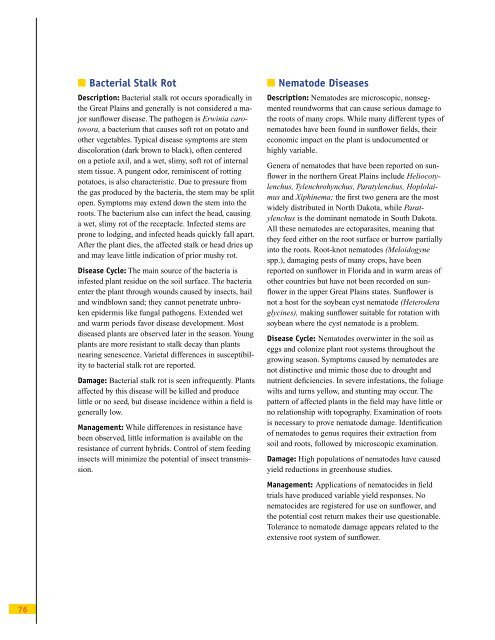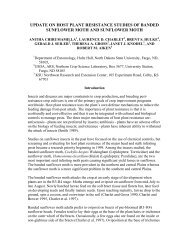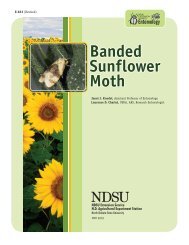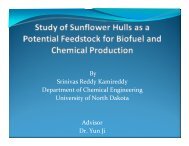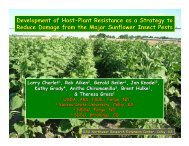Sunflower Production - NDSU Agriculture - North Dakota State ...
Sunflower Production - NDSU Agriculture - North Dakota State ...
Sunflower Production - NDSU Agriculture - North Dakota State ...
Create successful ePaper yourself
Turn your PDF publications into a flip-book with our unique Google optimized e-Paper software.
■ Bacterial Stalk RotDescription: Bacterial stalk rot occurs sporadically inthe Great Plains and generally is not considered a majorsunflower disease. The pathogen is Erwinia carotovora,a bacterium that causes soft rot on potato andother vegetables. Typical disease symptoms are stemdiscoloration (dark brown to black), often centeredon a petiole axil, and a wet, slimy, soft rot of internalstem tissue. A pungent odor, reminiscent of rottingpotatoes, is also characteristic. Due to pressure fromthe gas produced by the bacteria, the stem may be splitopen. Symptoms may extend down the stem into theroots. The bacterium also can infect the head, causinga wet, slimy rot of the receptacle. Infected stems areprone to lodging, and infected heads quickly fall apart.After the plant dies, the affected stalk or head dries upand may leave little indication of prior mushy rot.Disease Cycle: The main source of the bacteria isinfested plant residue on the soil surface. The bacteriaenter the plant through wounds caused by insects, hailand windblown sand; they cannot penetrate unbrokenepidermis like fungal pathogens. Extended wetand warm periods favor disease development. Mostdiseased plants are observed later in the season. Youngplants are more resistant to stalk decay than plantsnearing senescence. Varietal differences in susceptibilityto bacterial stalk rot are reported.Damage: Bacterial stalk rot is seen infrequently. Plantsaffected by this disease will be killed and producelittle or no seed, but disease incidence within a field isgenerally low.Management: While differences in resistance havebeen observed, little information is available on theresistance of current hybrids. Control of stem feedinginsects will minimize the potential of insect transmission.■ Nematode DiseasesDescription: Nematodes are microscopic, nonsegmentedroundworms that can cause serious damage tothe roots of many crops. While many different types ofnematodes have been found in sunflower fields, theireconomic impact on the plant is undocumented orhighly variable.Genera of nematodes that have been reported on sunflowerin the northern Great Plains include Heliocotylenchus,Tylenchrohynchus, Paratylenchus, Hoplolaimusand Xiphinema; the first two genera are the mostwidely distributed in <strong>North</strong> <strong>Dakota</strong>, while Paratylenchusis the dominant nematode in South <strong>Dakota</strong>.All these nematodes are ectoparasites, meaning thatthey feed either on the root surface or burrow partiallyinto the roots. Root-knot nematodes (Meloidogynespp.), damaging pests of many crops, have beenreported on sunflower in Florida and in warm areas ofother countries but have not been recorded on sunflowerin the upper Great Plains states. <strong>Sunflower</strong> isnot a host for the soybean cyst nematode (Heteroderaglycines), making sunflower suitable for rotation withsoybean where the cyst nematode is a problem.Disease Cycle: Nematodes overwinter in the soil aseggs and colonize plant root systems throughout thegrowing season. Symptoms caused by nematodes arenot distinctive and mimic those due to drought andnutrient deficiencies. In severe infestations, the foliagewilts and turns yellow, and stunting may occur. Thepattern of affected plants in the field may have little orno relationship with topography. Examination of rootsis necessary to prove nematode damage. Identificationof nematodes to genus requires their extraction fromsoil and roots, followed by microscopic examination.Damage: High populations of nematodes have causedyield reductions in greenhouse studies.Management: Applications of nematocides in fieldtrials have produced variable yield responses. Nonematocides are registered for use on sunflower, andthe potential cost return makes their use questionable.Tolerance to nematode damage appears related to theextensive root system of sunflower.76


